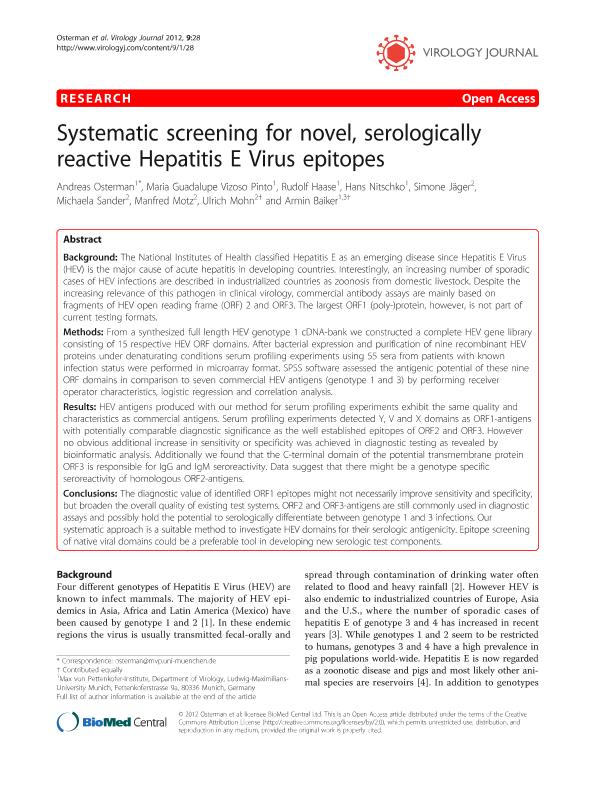Mostrar el registro sencillo del ítem
dc.contributor.author
Ostermann Porcel, María Victoria

dc.contributor.author
Vizoso Pinto, María Guadalupe

dc.contributor.author
Haase, Rudolf
dc.contributor.author
Nitschko, Hans
dc.contributor.author
Jaeger, Simone
dc.contributor.author
Sander, Michaela
dc.contributor.author
Motz, Manfred
dc.contributor.author
Mohn, Ulrich
dc.contributor.author
Baiker, Armin

dc.date.available
2019-02-11T21:59:03Z
dc.date.issued
2012-01
dc.identifier.citation
Ostermann Porcel, María Victoria; Vizoso Pinto, María Guadalupe; Haase, Rudolf; Nitschko, Hans; Jaeger, Simone; et al.; Systematic screening for novel, serologically reactive Hepatitis e Virus epitopes; BioMed Central; Virology Journal; 9; 1-2012; 1-9
dc.identifier.issn
1743-422X
dc.identifier.uri
http://hdl.handle.net/11336/69950
dc.description.abstract
Background: The National Institutes of Health classified Hepatitis E as an emerging disease since Hepatitis E Virus (HEV) is the major cause of acute hepatitis in developing countries. Interestingly, an increasing number of sporadic cases of HEV infections are described in industrialized countries as zoonosis from domestic livestock. Despite the increasing relevance of this pathogen in clinical virology, commercial antibody assays are mainly based on fragments of HEV open reading frame (ORF) 2 and ORF3. The largest ORF1 (poly-)protein, however, is not part of current testing formats. Methods. From a synthesized full length HEV genotype 1 cDNA-bank we constructed a complete HEV gene library consisting of 15 respective HEV ORF domains. After bacterial expression and purification of nine recombinant HEV proteins under denaturating conditions serum profiling experiments using 55 sera from patients with known infection status were performed in microarray format. SPSS software assessed the antigenic potential of these nine ORF domains in comparison to seven commercial HEV antigens (genotype 1 and 3) by performing receiver operator characteristics, logistic regression and correlation analysis. Results: HEV antigens produced with our method for serum profiling experiments exhibit the same quality and characteristics as commercial antigens. Serum profiling experiments detected Y, V and X domains as ORF1-antigens with potentially comparable diagnostic significance as the well established epitopes of ORF2 and ORF3. However no obvious additional increase in sensitivity or specificity was achieved in diagnostic testing as revealed by bioinformatic analysis. Additionally we found that the C-terminal domain of the potential transmembrane protein ORF3 is responsible for IgG and IgM seroreactivity. Data suggest that there might be a genotype specific seroreactivity of homologous ORF2-antigens. Conclusions: The diagnostic value of identified ORF1 epitopes might not necessarily improve sensitivity and specificity, but broaden the overall quality of existing test systems. ORF2 and ORF3-antigens are still commonly used in diagnostic assays and possibly hold the potential to serologically differentiate between genotype 1 and 3 infections. Our systematic approach is a suitable method to investigate HEV domains for their serologic antigenicity. Epitope screening of native viral domains could be a preferable tool in developing new serologic test components.
dc.format
application/pdf
dc.language.iso
eng
dc.publisher
BioMed Central

dc.rights
info:eu-repo/semantics/openAccess
dc.rights.uri
https://creativecommons.org/licenses/by/2.5/ar/
dc.subject
Hepatitis e Virus
dc.subject
Genomw-Wide
dc.subject
Serology
dc.subject
Viral Antigens
dc.subject
Diagnostic Test Development
dc.subject.classification
Inmunología

dc.subject.classification
Medicina Básica

dc.subject.classification
CIENCIAS MÉDICAS Y DE LA SALUD

dc.subject.classification
Otras Ciencias Biológicas

dc.subject.classification
Ciencias Biológicas

dc.subject.classification
CIENCIAS NATURALES Y EXACTAS

dc.title
Systematic screening for novel, serologically reactive Hepatitis e Virus epitopes
dc.type
info:eu-repo/semantics/article
dc.type
info:ar-repo/semantics/artículo
dc.type
info:eu-repo/semantics/publishedVersion
dc.date.updated
2019-01-14T15:04:06Z
dc.journal.volume
9
dc.journal.pagination
1-9
dc.journal.pais
Reino Unido

dc.journal.ciudad
Londres
dc.description.fil
Fil: Ostermann Porcel, María Victoria. Ludwig Maximilians Universitat. Max Von Pettenkofer Institute. Cátedra Virology; Alemania. Consejo Nacional de Investigaciones Científicas y Técnicas. Centro Científico Tecnológico Conicet - San Luis. Instituto de Investigaciones en Tecnología Química. Universidad Nacional de San Luis. Facultad de Química, Bioquímica y Farmacia. Instituto de Investigaciones en Tecnología Química; Argentina
dc.description.fil
Fil: Vizoso Pinto, María Guadalupe. Ludwig Maximilians Universitat. Max Von Pettenkofer Institute. Cátedra Virology; Alemania. Consejo Nacional de Investigaciones Científicas y Técnicas. Centro Científico Tecnológico Conicet - Tucumán. Instituto Superior de Investigaciones Biológicas. Universidad Nacional de Tucumán. Instituto Superior de Investigaciones Biológicas; Argentina
dc.description.fil
Fil: Haase, Rudolf. Ludwig Maximilians Universitat. Max Von Pettenkofer Institute. Cátedra Virology; Alemania
dc.description.fil
Fil: Nitschko, Hans. Ludwig Maximilians Universitat. Max Von Pettenkofer Institute. Cátedra Virology; Alemania
dc.description.fil
Fil: Jaeger, Simone. Mikrogen GmbH; Alemania
dc.description.fil
Fil: Sander, Michaela. Mikrogen Gmbh; Alemania
dc.description.fil
Fil: Motz, Manfred. Mikrogen Gmbh; Alemania
dc.description.fil
Fil: Mohn, Ulrich. Mikrogen Gmbh; Alemania
dc.description.fil
Fil: Baiker, Armin. Ludwig Maximilians Universitat. Max Von Pettenkofer Institute. Cátedra Virology; Alemania. Bavarian Health and Food Safety Authority; Alemania
dc.journal.title
Virology Journal

dc.relation.alternativeid
info:eu-repo/semantics/altIdentifier/url/http://www.virologyj.com/content/9/1/28/abstract
dc.relation.alternativeid
info:eu-repo/semantics/altIdentifier/doi/https://doi.org/10.1186/1743-422X-9-28
dc.relation.alternativeid
info:eu-repo/semantics/altIdentifier/url/https://virologyj.biomedcentral.com/articles/10.1186/1743-422X-9-28
Archivos asociados
